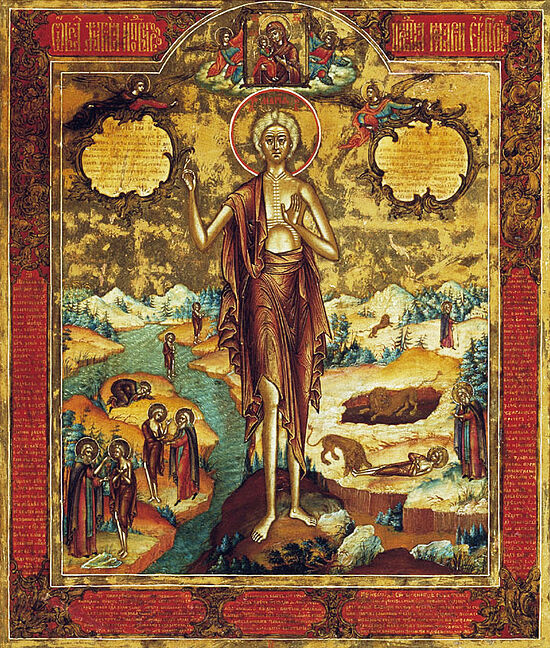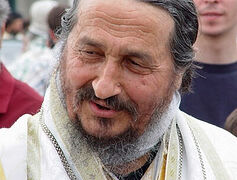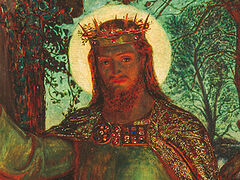The life of St. Mary of Egypt, now remembered by the holy Church, is probably known to most of you. You know that she was a great sinner, a harlot, who ensnared very many in the net of iniquity. You know how later, being prevented from venerating the wood of the Lifegiving Cross of Christ with the others, she repented and retired into the desert, where she labored in the asceticism of fasting, prayer, and battling with her passions for forty-seven years, and how she so overcame the passions of the flesh by her labors that she became like the bodiless angels: She elevated from the earth during times of prayer and easily walked upon the waters of the Jordan.
Perhaps some of you may wonder why we, so young and unfamiliar with the depths of the passions, are being reminded of one who was a great sinner, “plunged into the abyss of evil?”1
So that, first of all, no one will treat the sins of their youth lightly. But most people do look at the sins of their youth too lightly, like innocent, cute little amusements that won’t leave any trace in the soul afterwards. How deeply deluded these people are! Recall that at the age of eleven, St. Mary left her parents’ home for Alexandria to indulge in a sinful life. And how many troubles were caused by these sins that began in her youth! How she was tormented in the desert by memories of her former sinful life; how she fell to the ground out of exhaustion from the battle with the passions and lay senseless for days; how she experienced the torments of hell while on Earth from this battle, being scorched by the fire of the passions that flared up in her heart, and externally enduring now the cold, now the heat in the desert! It’s absolutely in vain to think that it’s not youth but old age that’s the most convenient time for fighting the passions. Youth is the age when one’s whole subsequent life is quite often defined, whether towards the good or towards the evil. This is what St. John the Theologian says about this age: I write unto you, young men, because ye have overcome the wicked one (1 Jn. 2:13); that is, you’re strong to fight the passions and their culprit, the devil, and can most conveniently overcome them now.
People who consider the sins of their youth of little importance forget that little sins easily become great ones. Sin begins with a thought, sometimes arising in the soul completely involuntarily, and if the thought isn’t immediately driven away, then comes the mind’s attention to it, then the delight of the heart, then the decision of the will and the act itself: From sinful deeds are born the passions, which strengthened by repetition, become irresistible. Hence, it’s clear that just as a spark must be extinguished immediately, before it ignites some flammable substance and causes a fire, so the battle with sin must begin from the first, with the expulsion of sinful thoughts from the soul. It’s especially important to say this about the passion that St. Mary enslaved herself to—the most powerful and irresistible passion. What an abyss of perdition this passion plunges us into if we don’t start fighting with it in time! Hence the falls, hence the sorrows and spiritual torments, hence the mutual hatred and enmity going all the way to murder, hence the treason, the disorder of families, the death of children!...
True, you’re growing up here under the shadow of the holy Church and you’re protected to some extent from the danger of falling into the passions to which St. Mary was devoted, but then again, the Church’s sanctification of our souls doesn’t happen against our will—we need love to be as deeply rooted in our souls as the passions were in the soul of St. Mary. It’s not those who only come to church sometimes out of habit and as if against their own will who are imbued with the spirit of ecclesiality, but those who, even when not in church, like St. Mary, have implanted Christ into their hearts as deeply as her; those who with so many tears and sighs have, like her, uprooted from the soul the passions that were battling against it.
Having pulled her own soul out of the abyss of perdition by great asceticism and having set it on the path of salvation, St. Mary has become an image of repentance for all generations. Here’s an indication of how people should prepare to instruct others. There have always been many who desire to teach others, including many women, who want to become bearers and propagators of the light of Christ—while others want to spread the ideas and concepts of their own age amongst the people and society. The former are likened to those women who in the early days of Christianity performed the Apostolic ministry by helping the Apostles. But let those who desire to teach others and to be apostles not forget how St. Mary became an example of repentance for the nations, as the Apostles albeit also not without ascetic exploits became the propagators of the light of Christ on Earth: For Thy sake, they said of themselves, we are killed all the day long (Rom. 8:36); I discipline my body and bring it into subjection, lest, when I have preached to others, I myself should become disqualified (1 Cor. 9:27). Without this asceticism, women who desire to teach others can easily find themselves among those whom the Apostle characterized as led away with divers lusts, Ever learning, and never able to come to the knowledge of the truth (2 Tim. 3:6-7).
May the image of St. Mary be a memorial for us and may the remembrance of her be a source of constant edification for us! May this memory make our hearts more sensitive to small sins that turn into great sins due to negligence; may this sensitivity of conscience not be lost, especially in our women’s hearts, which are more sensitive by nature! May the memory of St. Mary’s asceticism, who labored in the desert for forty-seven years, arouse us to a persistent and patient battle with our passions; and if someone happens to fall into some sin and becomes a slave to the passion, may the memory of the great mercy of God, Who pulled such a great sinner from the depths of destruction, preserve the fallen from despair!
Amen.




